Christie's. Masterpieces of Early Chinese Gold and Silver, New York, 12 September 2019
Lot 527. A pair of parcel-gilt silver hairpins, Tang dynasty (618-907). Each 13 1/8 in. (33.2 cm.) long, total weight 42.8 g. Estimate USD 4,000 - USD 6,000. © Christie's Image Ltd 2019.
The openwork head of each hammered silver, double-pronged hairpin has a fine openwork design of a lion facing a small bird perched on top of a large feathered plume surrounded by scrolling tendrils, leather box.
Provenance: Dr. Johan Carl Kempe (1884-1967) Collection, Sweden, before 1954.
Sotheby's London, Masterpieces of Chinese Precious Metalwork. Early Gold and Silver, 14 May 2008, lot 79.
Literature: Mostra d'Arte Cinese, Venice, 1954, p. 87, pl. 282.
Chinese Gold and Silver in the Carl Kempe Collection, The Museum of Art and Far Eastern Antiquities in Ulricehamn, Ulricehamn, 1999, pl. 133.
Exhibited: Venice, Palazzo Ducale, Mostra d'Arte Cinese, 1954, cat. no. 282.



Lot 540. A rare silver spherical censer, Tang dynasty (618-907); 1 5/8 in. (4.3 cm.) diam.; weight 37.5 g. Estimate USD 60,000 - USD 80,000. © Christie's Image Ltd 2019.
The globular censer is comprised of two, hinged openwork hemispheres suspended on a hooked chain. The upper hemisphere has a design of leafy, scrolling vines bearing two fruits flanked by pairs of birds, which alternate with two flowers above palmette-like leaves, while the lower hemisphere has a similar design, but no birds. The interior is fitted with a gimbaled system of rings holding a gilt-bronze cup upright irrespective of the movement of the outer sphere.
Provenance: Dr. Johan Carl Kempe (1884-1967) Collection, Sweden, before 1953, no. CK96.
Sotheby's London, Masterpieces of Chinese Precious Metalwork. Early Gold and Silver, 14 May 2008, lot 57.
Literature: Bo Gyllensvärd, Chinese Gold and Silver in the Carl Kempe Collection, Stockholm, 1953, cat. no. 96.
Bo Gyllensvärd, 'T'ang Gold and Silver', Bulletin of the Museum of Far Eastern Antiquities, No. 29, Stockholm, 1957, pl. 5d, fig. 11b.
Han Wei, Hai nei wai Tangdai jin yin qi cuibian [Tang Gold and Silver in Chinese and overseas collections], Xi'an, 1989, pl. 293.
Chinese Gold and Silver in the Carl Kempe Collection. The Museum of Art and Far Eastern Antiquities in Ulricehamn, Ulricehamn, 1999, pl. 98.
Qi Dongfang, Tangdai jin yin qi yan jiu [Research on Tang gold and silver], Beijing, 1999, pl. 92.
Exhibited: Washington, D.C., Smithsonian Institution, Chinese Gold and Silver in the Carl Kempe Collection, 1954-55, cat. no. 96.
New York, Asia House Gallery, Chinese Gold, Silver and Porcelain. The Kempe Collection, 1971, cat. no. 44, an exhibition touring the United States and shown also at nine other museums.
Note: Censer/perfumers of this type, formed as an openwork sphere pendent from a chain, were used for both secular and religious purposes during the Tang dynasty. They held a variety of aromatic substances, some to be burned as incense, others to more slowly release their scent. The interior of these censers has a gimbaled arrangement of two silver bands holding a gilt-bronze, hemispherical incense receptacle in the center in which the aromatics were placed. This mechanism insured that the receptacle would at all times remain upright. These censers were used to freshen interiors and clothes and perhaps to repel insects. For a discussion of the use of aromatics, incense and perfume in the Tang period, see E. H. Schafer, The Golden Peaches of Samarkand, University of California, 1963.
A similar censer unearthed in 1970, Hejiacun, Xi'an, Shaanxi province, is illustrated in Tangdai jin yin qi, 1985, figs. 95 and 96, where the design and construction are fully described, and again in Selected Treasures from Hejiacun Tang Hoard, Shaanxi History Museum, Wenwu, 2003, pp. 222-25. Another similar censer, formerly in the Hakutsuru Museum, Kobe, Japan, is illustrated in Tang, Eskenazi, London, 1987, no. 1. See, also, the similar example illustrated in Chinesisches Gold und Silber: Die Sammlung Pierre Uldry, Zurich, 1994, no. 201, and the example from the William Rockhill Nelson Gallery of Art, Kansas City, illustrated by Jan Fontein and Tung Wu, Unearthing China's Past, Museum of Fine Arts, Boston, 1973, p. 178, no. 91, where the authors note that "according to the Miscellaneous Records of the Western Capital the 'Cardan' method of suspension was already in use during the Western Han period."


Lot 541. A small silver circular 'bird and flower' box and cover, Tang dynasty (618-907); 1 5/8 in. (4.2 cm.) diam.; weight 38.5 g. Estimate USD 7,000 - USD 9,000. © Christie's Image Ltd 2019.
The small, slightly convex box and cover are each finely chased with a central bird in flight encircled by five other birds, one standing, the others in flight amidst leafy flower stems, and the straight sides with delicate foliate scroll, all finely reserved on a minutely ring-punched ground.
Provenance: Dr. Johan Carl Kempe (1884-1967) Collection, Sweden, before 1953, no. CK112.
Sotheby's London, Masterpieces of Chinese Precious Metalwork. Early Gold and Silver, 14 May 2008, lot 83.
Literature: Bo Gyllensvärd, Chinese Gold and Silver in the Carl Kempe Collection, Stockholm, 1953, pl. 112.
Bo Gyllensvärd, ‘T’ang Gold and Silver’, Bulletin of the Museum of Far Eastern Antiquities, No. 29, Stockholm, 1957, figs. 42c, 54b, 62n, 67g.
Han Wei, Hai nei wai Tangdai jin yin qi cui bian, [Tang Gold and Silver in Chinese and overseas collections], Xi’an, 1989, pl. 219.
Chinese Gold and Silver in the Carl Kempe Collection, The Museum of Art and Far Eastern Antiquities in Ulricehamn, Ulricehamn, 1999, pl. 115.
Exhibited: Washington, D.C., Smithsonian Institution, Chinese Gold and Silver in the Carl Kempe Collection, 1954-55, cat. no. 112.

Lot 542. A miniature circular parcel-gilt silver box and cover, Tang dynasty (618-907); 7/8 in. (2.3 cm.) diam.; weight 7.8 g. Estimate USD 3,000 - USD 5,000. © Christie's Image Ltd 2019.
The slightly convex cover is chased and parcel-gilded with a central blossom from which radiates leafy stems, and the straight sides of the cover and the box are similarly decorated with foliate motifs, all on a ring-punched ground. The base of the box is flat and undecorated.
Provenance: Dr. Johan Carl Kempe (1884-1967) Collection, Sweden, before 1953, no. CK92.
Sotheby's London, Masterpieces of Chinese Precious Metalwork. Early Gold and Silver, 14 May 2008, lot 82.
Literature: Bo Gyllensvärd, Chinese Gold and Silver in the Carl Kempe Collection, Stockholm, 1953, cat. no. 92.
Bo Gyllensvärd, 'T'ang Gold and Silver', Bulletin of the Museum of Far Eastern Antiquities, No. 29, Stockholm, 1957, fig. 80n.
Chinese Gold and Silver in the Carl Kempe Collection, The Museum of Art and Far Eastern Antiquities in Ulricehamn, Ulricehamn, 1999, pl. 94.
Exhibited: Washington, D.C., Smithsonian Institution, Chinese Gold and Silver in the Carl Kempe Collection, 1954-55, cat. no. 92.

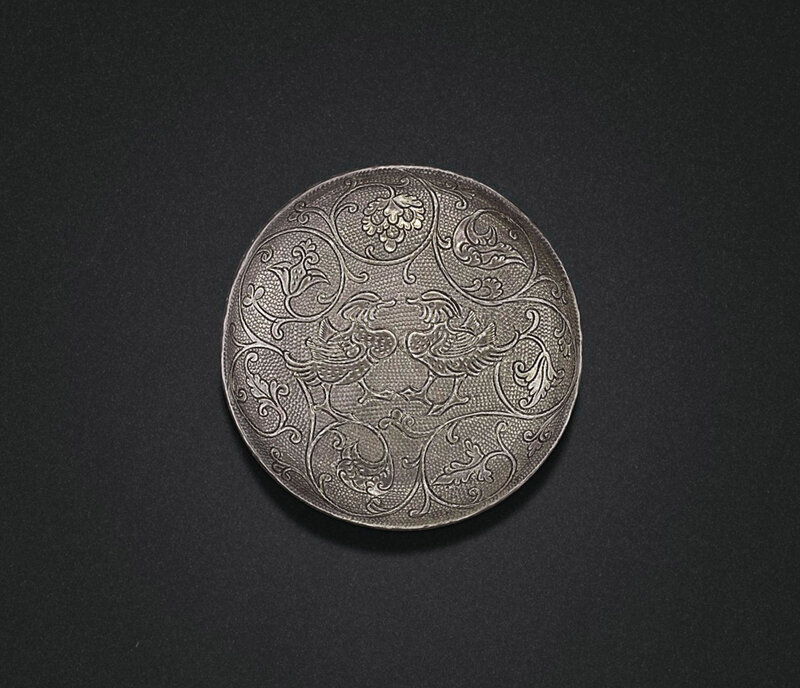

Lot 544. A finely engraved small silver 'Mandarin duck' box and cover, Tang dynasty (618-907); 1 ¾ in. (4.4 cm.) diam.; weight 37 g. Estimate USD 25,000 - USD 35,000. © Christie's Image Ltd 2019.
Both sides of the convex box are chased with a pair of confronted mandarin ducks enclosed by leafy, foliate scroll, and the upright sides with further foliate scroll, all on a ring-punched ground.
Provenance: Dr. Johan Carl Kempe (1884-1967) Collection, Sweden, before 1953, no. CK94.
Sotheby's London, Masterpieces of Chinese Precious Metalwork. Early Gold and Silver, 14 May 2008, lot 42.
Literature: Bo Gyllensvärd, Chinese Gold and Silver in the Carl Kempe Collection, Stockholm, 1953, cat. no. 94.
Bo Gyllensvärd, 'T'ang Gold and Silver', Bulletin of the Museum of Far Eastern Antiquities, No. 29, Stockholm, 1957, figs. 68b, 80r, 93k.
Chinese Gold and Silver in the Carl Kempe Collection, The Museum of Art and Far Eastern Antiquities in Ulricehamn, Ulricehamn, 1999, pl. 96.
Exhibited: Washington, D.C., Smithsonian Institution, Chinese Gold and Silver in the Carl Kempe Collection, 1954-55, cat. no. 94.
New York, Asia House Gallery, Chinese Gold, Silver and Porcelain. The Kempe Collection, 1971, cat. no. 42, an exhibition touring the United States and shown also at nine other museums.
Note: The decoration of a pair of mandarin ducks on this box can be seen on other small silver boxes of Tang date, such as the example of even smaller size (2.9 cm.) illustrated in World of the Heavenly Khan: Treasures of the Tang Dynasty, National Palace Museum, Taipei, 2002, p. 56. Unlike the pair of ducks on the present box, which are shown confronted, these ducks are shown standing side-by-side on a lotus leaf. A pair of confronted ducks standing on a lotus decorates the top of a parcel-gilt silver box excavated in 1970 from Prince Bin's treasure hoard at Hejiacun, Shaanxi province, illustrated by Han Wei and Christian Deydier, Ancient Chinese Gold, Paris, 2001, p. 229, pls. 546-547. As one can see in pl. 547, the bottom of the box has different decoration, as does the bottom of the present box. A pair of mandarin ducks, especially when combined with lotus (yuanyang), conveys the wish for a harmonious marriage, making it fitting decoration for a lady's silver box.


Lot 545. A small finely engraved silver stem cup, Tang dynasty (618-907); 2 in. (5.1 cm.) high; weight 36.4 g. Estimate USD 40,000 - USD 60,000. © Christie's Image Ltd 2019.
The bell-shaped cup is raised on a knopped stem foot with spreading base. The deep sides are finely engraved with elaborate scrolling grapevine on a very fine ring-punched ground below a similar band at the mouth rim, all above a petal band and a saw-tooth band encircling the circular ring at the top of the stem.
Provenance: Dr. Johan Carl Kempe (1884-1967) Collection, Sweden, before 1953, no. CK102.
Sotheby's London, Masterpieces of Chinese Precious Metalwork. Early Gold and Silver, 14 May 2008, lot 47.
Literature: Bo Gyllensvärd, Chinese Gold and Silver in the Carl Kempe Collection, Stockholm, 1953, cat. no. 102.
Bo Gyllensvärd, ‘T’ang Gold and Silver’, Bulletin of the Museum of Far Eastern Antiquities, Stockholm, No. 29, 1957, figs. 55a, 75c, 86b, 87f.
Han Wei, Hai nei wai Tangdai jin yin qi cui bian, [Tang Gold and Silver in Chinese and overseas collections], Xi’an, 1989, pl. 44.
Chinese Gold and Silver in the Carl Kempe Collection, The Museum of Art and Far Eastern Antiquities in Ulricehamn, Ulricehamn, 1999, pl. 104.
Exhibited: Washington, D.C., Smithsonian Institution, Chinese Gold and Silver in the Carl Kempe Collection, 1954-55, cat. no. 102.
Note: Cups of this goblet shape were popular during the Tang dynasty, and are found with varying decorations, often a scrolling foliate pattern, and more rarely a scrolling grapevine such as that seen on the present cup. A stem cup with this decoration is illustrated in Sui to no bijutsu, Osaka Municipal Art Museum, 1976, p. 32, no. 2-23. It can also be seen on two bottle-shaped silver vases of Tang date, illustrated by Clarence W. Kelley, Chinese Gold & Silver in American Collections, The Dayton Art Institute, Dayton, Ohio, 1984, no. 49, dated early 8th century, and no. 50, dated late 8th-9th century. On both of these, birds and animals are interspersed amidst the grape vine. A cup of this form decorated with scrolling grape vines was unearthed from the reliquary chamber of the pagoda at the Qingshan Temple in Lindongxian, Shaanxi province. The construction of the temple was begun in AD 736, and in AD 740 the reliquary was placed in the subterranean chamber of the pagoda along with other objects of gold, silver, bronze and ceramic.

Lot 546. A finely engraved silver cup, Tang dynasty (618-907); 1 ¾ in. (4.5 cm.) high; weight 53.3 g. Estimate USD 50,000 - USD 70,000. © Christie's Image Ltd 2019.
The sides are finely engraved and chased on the exterior with a formally arranged pattern of conjoined foliate scrolls, all against a ring-punched ground above the low, flaring ring foot. One side is applied with a ring-handle with a projecting thumb piece on top.
Provenance: Dr. Johan Carl Kempe (1884-1967) Collection, Sweden, before 1953, no. CK90.
Sotheby's London, Masterpieces of Chinese Precious Metalwork. Early Gold and Silver, 14 May 2008, lot 43.
Literature: Bo Gyllensvärd, Chinese Gold and Silver in the Carl Kempe Collection, Stockholm, 1953, cat. no. 90.
Bo Gyllensvärd, ‘T’ang Gold and Silver’, Bulletin of the Museum of Far Eastern Antiquities, No. 29, Stockholm, 1957, pl. 12b, figs 24g, 78i.
Han Wei, Hai nei wai Tangdai jin yin qi cui bian, [Tang Gold and Silver in Chinese and overseas collections], Xi’an, 1989, pl. 72.
Chinese Gold and Silver in the Carl Kempe Collection, The Museum of Art and Far Eastern Antiquities in Ulricehamn, Ulricehamn, 1999, pl. 92.
Qi Dongfang, Tangdai jin yin qi yan jiu [Research on Tang gold and silver], Beijing, 1999, pl.12.
Exhibited: Washington, D.C., Smithsonian Institution, Chinese Gold and Silver in the Carl Kempe Collection, 1954-1955, cat. no. 90.
New York, Asia House Gallery, Chinese Gold, Silver and Porcelain. The Kempe Collection, 1971, cat. no. 40 an exhibition touring the United States and shown also at nine other museums.
Oxford, Ashmolean Museum, From Silver to Ceramics, the Potter's Debt to Metal Work in the Graeco-Roman, Oriental and Islamic Worlds, 1986, pl. 33 (bottom).
Note: Tang-dynasty silver cups of this elegant, slightly waisted shape are known both with and without a handle. One of the latter type, decorated with geese in flight amidst plants, is illustrated by Han Wei and Christian Deydier, Ancient Chinese Gold, Paris, 2001, p. 151, pl. 374. Examples with a handle similar to that on the present cup, include the cup illustrated in Tang, Eskenazi, London, 1987, no. 8, which is decorated with scrolling grapevine and peony scroll on a ring-punched ground, and two others illustrated in Zui to no bijutsu, Osaka Municipal Museum, 1976, nos. 2-28 and 2-30. The handle on the Eskenazi cup is described as being "pinned to the cup through a floral applique." Unlike the decoration on the aforementioned cups, the decoration on the present cup covers the entire surface of the sides rather than being separated by a narrow bow-string band from a narrow band of decoration below the rim.



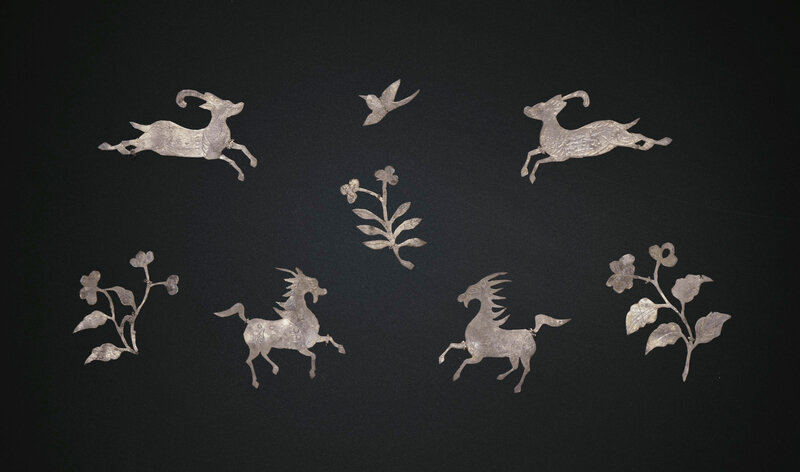


Lot 547. A set of thirty-two gold and silver sheet ornaments, pingtuo, Tang dynasty (618-907)The largest ornament 1 5/8 in. (4.3 cm.) wide. Estimate USD 30,000 - USD 50,000. © Christie's Image Ltd 2019.
The ornaments are all cut from thin gold or silver sheets depicting various animals and birds, such as phoenixes and other birds in flight, qilin, lions or gazelles. Each ornament has finely engraved details, mounted in three frames.
Provenance: Dr. Johan Carl Kempe (1884-1967) Collection, Sweden, before 1953, nos. CK43 and CK123.
Sotheby's London, Masterpieces of Chinese Precious Metalwork. Early Gold and Silver, 14 May 2008, lot 70.
Literature: Bo Gyllensvärd, Chinese Gold and Silver in the Carl Kempe Collection, Stockholm, 1953, cat. nos. 43 and 123.
Bo Gyllensvärd, 'T'ang Gold and Silver', Bulletin of the Museum of Far Eastern Antiquities, No. 29, Stockholm, 1957, figs. 57d, 62r and 70o.
The silver ornaments: Chinese Gold and Silver in the Carl Kempe Collection, The Museum of Art and Far Eastern Antiquities in Ulricehamn, Ulricehamn, 1999, pls. 41 and 126.
Exhibited: Washington, D.C., Smithsonian Institution, Chinese Gold and Silver in the Carl Kempe Collection, 1954-55, cat. nos. 43 and 123.
New York, Asia House Gallery, Chinese Gold, Silver and Porcelain. The Kempe Collection, 1971, cat. no. 18 (nine birds), an exhibition touring the United States and shown also at nine other museums.
Note: These gold and silver sheet bird and animal-ornaments would have been made as pingtuo inlay for the lacquered backs of bronze mirrors of Tang-dynasty date. Mirrors of this type reflected the splendor and sumptuous taste of the Tang court, and also found their way to Japan, perhaps as diplomatic gifts. An eight-lobed mirror of this type in the Shoso-in is illustrated by Ryochi Hayashi, The Silk Road and the Shoso-in, New York/Tokyo, 1975, p. 129, fig. 142. Others include the circular example inlaid in silver with a pheonix and a peacock, as well as other birds in flight, illustrated in Ancient Bronze Mirrors from the Shanghai Museum, Beijing, 2005, pl. 84, and another of square quadrilobed shape in silver with four phoenixes, pl. 83. An octalobed mirror of this type is illustrated in Zhongguo meishu quanji, vol. 8, Arts and Crafts - Lacquerware, Beijing, 1989, p. 80, no. 78. A fine rounded square example inlaid in gold and silver with four phoenixes is illustrated by Suzanne E. Cahill, The Lloyd Cotsen Study Collection of Chinese Bronze Mirrors, vol. II, Studies, p. 162, fig. 1. See, also, the two gold and silver pingtuo-inlaid lacquered bronze mirrors from the Arthur M. Sackler Collections sold at Christie's New York, 18 March 2009, lot 240 and 14 September 2009, lot 34. A pair of gilded silver, phoenix-form cut-outs from the Falk Collection sold at Christie's New York, 16 October 2001, lot 189.

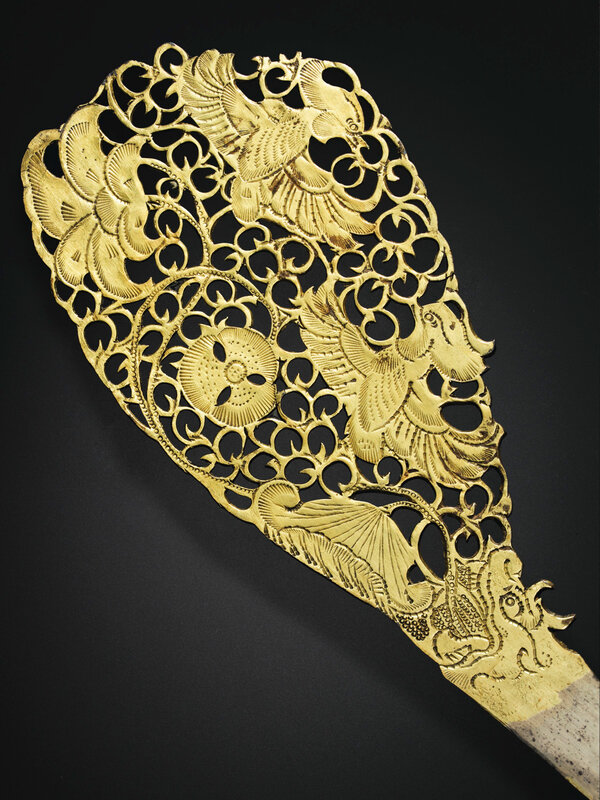
Lot 548. A rare pair of parcel-gilt silver hairpins, Tang dynasty (618-907). Each 11 in. (28 cm.) long; weight 17 and 17.6 g. Estimate USD 40,000 - USD 60,000. © Christie's Image Ltd 2019.
The gilded head of each double-pronged silver hairpin has a delicate, chased openwork design depicting a pair of mandarin ducks in flight amidst scrolling tendrils that also enclose a lotus leaf and flowers, all issuing from the jaws of a dragon head, leather box.
Provenance: Dr. Johan Carl Kempe (1884-1967) Collection, Sweden, before 1953, no. CK126.
Sotheby's London, Masterpieces of Chinese Precious Metalwork. Early Gold and Silver, 14 May 2008, lot 52.
Literature: Bo Gyllensvärd, Chinese Gold and Silver in the Carl Kempe Collection, Stockholm, 1953, cat. no. 126.
Bo Gyllensvärd, 'T'ang Gold and Silver', Bulletin of the Museum of Far Eastern Antiquities, No. 29, Stockholm, 1957, pl. 24d, fig. 84b.
Chinese Gold and Silver in the Carl Kempe Collection, The Museum of Art and Far Eastern Antiquities in Ulricehamn, Ulricehamn, 1999, pl. 136.
Exhibited: Washington, D.C., Smithsonian Institution, Chinese Gold and Silver in the Carl Kempe Collection, 1954-55, cat. no. 126.
New York, Asia House Gallery, Chinese Gold, Silver and Porcelain. The Kempe Collection, 1971, cat. no. 63, an exhibition touring the United States and shown also at nine other museums.
Note: The opulence of the Tang court is reflected not only in the use of gold and silver for the manufacture of vessels, but also for the decoration of everyday objects and personal adornment. For the ladies of the court this included rich jewelry such as necklaces, earrings and bracelets, as well as combs and hairpins that adorned their hair styles, which became more elaborate as the dynasty progressed. Later in the Tang period the ends of the hairpins were often made from thin sheet silver with cut-out designs that made them light in weight and, along with the addition of gilding, made the hairpins shimmer and quiver as the woman moved.
The present hairpins are very similar to one dated Tang dynasty, late 8th-9th century, in the collection of the Art Museum, Princeton University, and illustrated by Clarence W. Kelley, Chinese Gold and Silver in American Collections, The Dayton Art Institute, Dayton, Ohio, 1984, p. 39, no. 5. (Fig. 1) Other similar hairpins include one originally in the collection of the Hon. Senator Hugh Scott and now in the collection of Pierre Uldry, illustrated in Chinesishes Gold und Silber, Zurich, 1994, p. 205, no. 219, and the example illustrated by Han Wei and Christian Deydier, Ancient Chinese Gold, Paris, 2001, p. 134, pl. 331. A related gilt-silver hairpin in the Royal Ontario Museum is illustrated in Homage to Heaven, Homage to Earth, Toronto, 1992, p. 223, pl. 127 (bottom). All of these hairpins include a pair of confronted mandarin ducks, an appropriate motif for a lady of the court as mandarin ducks symbolize connubial bliss and fidelity. Two further openwork, gilded silver hairpins in the Royal Ontario Museum, also illustrated pl. 127, have similarly feminine motifs - one of knotted cords representing the unbreakable union of marriage, the other of a phoenix, the symbol of the empress who embodied all feminine attributes.



Lot 549. A very fine petal-lobed silver stem cup, Tang dynasty (618-907); 2 ¾ in. (6.9 cm.) diam.; weight 85 g. Estimate USD 50,000 - USD 70,000. © Christie's Image Ltd 2019.
The small bowl is divided into eight petal-shaped lobes, each delicately engraved with birds including ducks, geese and a parrot amidst rocks and trees in a landscape, the birds shown either in flight, or alternately looking towards or away from each other, all against a very fine ring-punched ground above engraved lotus petals rising from the stem foot with spreading, petal-lobed base similarly decorated with bands of foliate scrolls.
Provenance: Dr. Johan Carl Kempe (1884-1967) Collection, Sweden, before 1953, no. CK110.
Sotheby's London, Masterpieces of Chinese Precious Metalwork. Early Gold and Silver, 14 May 2008, lot 40.
Literature: Bo Gyllensvärd, Chinese Gold and Silver in the Carl Kempe Collection, Stockholm, 1953, cat. no. 110a.
Bo Gyllensvärd, 'T'ang Gold and Silver', Bulletin of the Museum of Far Eastern Antiquities, No. 29, Stockholm, 1957, pl. 8b, fig. 62m.
Han Wei, Hai nei wai Tangdai jin yin qi cuibian [Tang gold and silver in Chinese and overseas collections], Xi'an, 1989, pl. 59.
Chinese Gold and Silver in the Carl Kempe Collection, The Museum of Art and Far Eastern Antiquities in Ulricehamn, Ulricehamn, 1999, pl. 113.
Qi Dongfang, Tangdai jin yin qi yan jiu [Research on Tang gold and silver], Beijing, 1999, pl. 8.
Exhibited: Washington, D.C., Smithsonian Institution, Chinese Gold and Silver in the Carl Kempe Collection, 1954-55, cat. no. 110.
New York, Asia House Gallery, Chinese Gold, Silver and Porcelain. The Kempe Collection, 1971, cat. no. 54, an exhibition touring the United States and shown also at nine other museums.
Note: Silver stem cups of this elegant, lobed shape, where the lobes continue up to a slightly everted edge, are very rare. A very similar stem cup from the collection of Martin Mansson was sold at Christie's London, 10 May 2011, lot 178. The Mansson cup was referenced by Gyllensvärd in his various catalogues of the Kempe Collection as a comparable of the present cup. Another cup of this shape, decorated with hunting motifs, dated to the 8th century, is in the Hakutsuru Art Museum and illustrated by Ryoichi Hayashi, The Silk Road and the Shoso-in, New York/Tokyo, 1975, p. 86, pl. 88.


Lot 550. A very rare and finely engraved parcel-gilt silver jar and cover, Tang dynasty (618-907); 2 ½ in. (6.5 cm.) high; weight 136 g. Estimate USD 50,000 - USD 70,000. © Christie's Image Ltd 2019.
The globular body is engraved with four fully opened lotus blossoms, each enclosed by leafy, scrolling stems, all reserved and highlighted in gilding on a minutely ring-punched ground. The low, splayed foot is decorated with a sawtooth band. The cover is similarly decorated with a six-petaled flower centered by the knob.
Provenance: C. T. Loo & Co., New York, before 1941.
Dr. Johan Carl Kempe (1884-1967) Collection, Sweden, before 1953, no. CK93.
Sotheby's London, Masterpieces of Chinese Precious Metalwork. Early Gold and Silver, 14 May 2008, lot 63.
Literature: C. T. Loo & Co., Exhibition of Chinese Arts, New York, 1941, no. 182.
Bo Gyllensvärd, Chinese Gold and Silver in the Carl Kempe Collection, Stockholm, 1953, cat. no. 93.
Bo Gyllensvärd, 'T'ang Gold and Silver', Bulletin of the Museum of Far Eastern Antiquities, No. 29, Stockholm, 1957, figs. 34a, 85b.
R. Soame Jenyns and William Watson, Chinese Art. The Minor Arts, London, 1963, pl. 21.
Chinese Gold and Silver in the Carl Kempe Collection, The Museum of Art and Far Eastern Antiquities in Ulricehamn, Ulricehamn, 1999, pl. 95.
Qi Dongfang, Tangdai jin yin qi yan jiu [Research on Tang gold and silver], Beijing, 1999, pl. 87.
Exhibited: New York, C. T. Loo & Co. Exhibition of Chinese Arts, 1 November 1941-30 April 1942, no. 182.
Copenhagen, Dansk Kunstindustrimuseum, Kinas Kunst i Svensk og Dansk eje, 1950, cat. no. 192.
Washington, D.C., Smithsonian Institution, Chinese Gold and Silver in the Carl Kempe Collection, 1954-55, cat. no. 93.
New York, Asia House Gallery, Chinese Gold, Silver and Porcelain. The Kempe Collection, 1971, cat. no. 41, an exhibition touring the United States and shown also at nine other museums.
Note: No other similar parcel-gilt jar appears to be published, but a plain silver jar and cover of this shape from the Hejiacun hoard is shown in a line drawing illustrated by Qi Dongfang, Tangdai jin yin qi yan jiu (Research on Tang gold and silver), Bejing, 1999, p. 100, fig. 1-280. The pleasing globular shape of these silver jars is more usually found in ceramic examples of Tang date, such as the sancai-glazed pottery jar and cover, the jar raised on a spreading foot, illustrated by Osvald Sirén, Kinas Konst under Tre Artusenden, Stockholm, 1942, p. 188, fig. 209; and another sancai-glazed pottery jar and cover illustrated in the catalogue for the exhibition, Zui to no bijutsu, Osaka Municipal Art Museum, 1976, p. 8, no. 1:25. Jars of this shape are often referred to as 'apple' jars. Another sancai-glazed pottery jar and cover of this shape, in the collection of Mr. and Mrs. Eugene Bernat, is illustrated in the exhibition catalogue, The Arts of the T'ang Dynasty, Oriental Ceramic Society, London, 1955, pl. 7b, no. 135. This jar is raised on an integral stand, but one can see that it has a circular foot. A Xingyao jar and cover, also in the Kempe Collection, illustrated by Bo Gyllensvärd in the exhibition catalogue, Chinese Gold and Silver and Porcelain, Asia House Gallery, New York, 1971, p. 92, no. 79, has the same shape, a low foot, and is incised on the sides with four large petals.

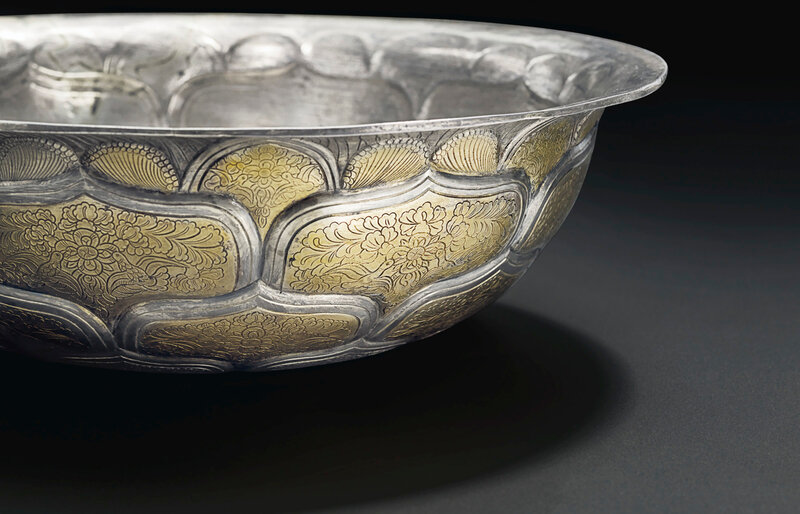
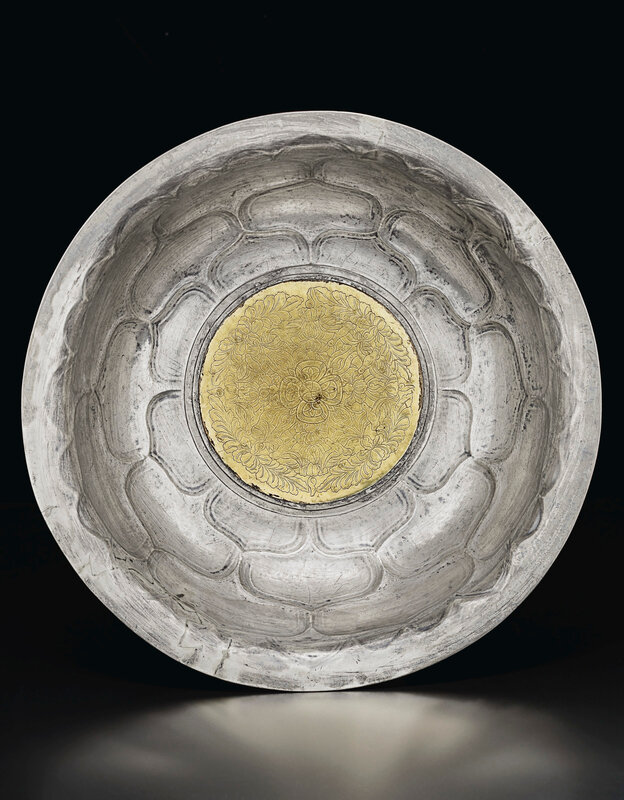
Lot 551. A very rare and important large parcel-gilt silver bowl, Tang dynasty (618-907); 9 5/8 in. (24.5 cm.) diam.; weight 1052 g. Estimate USD 2,000,000 - USD 3,000,000. © Christie's Image Ltd 2019.
The large bowl is finely worked in repoussé with three rows of overlapping lotus petals, each gilded and exquisitely chased with a pair of birds in flight confronted on a ribbon tied in four loops against a background of leafy foliate sprays amidst leafy foliage, all below a further row of smaller repoussé petals that alternate with clusters of stamen below slender lancelot leaf tips that point towards the everted rim. The center of the interior is chased with a large medallion depicting eight birds in flight against a background of leafy foliate sprays as they encircle a ribbon tied in four loops with trailing ends.
Provenance: Dr. Johan Carl Kempe (1884-1967) Collection, Sweden, before 1953, no. CK117.
Sotheby's London, Masterpieces of Chinese Precious Metalwork. Early Gold and Silver, 14 May 2008, lot 54.
Literature: Bo Gyllensvärd, Chinese Gold and Silver in the Carl Kempe Collection, Stockholm, 1953, pl. 117.
Bo Gyllensvärd, 'T'ang Gold and Silver', Bulletin of the Museum of Far Eastern Antiquities, No. 29, Stockholm, 1957, pl. 24b, fig. 39c.
Han Wei, Hai nei wai Tangdai jin yin qi cuibian [Tang gold and silver in Chinese and overseas collections], Xi'an, 1989, pl. 146.
Chinese Gold and Silver in the Carl Kempe Collection, The Museum of Art and Far Eastern Antiquities in Ulricehamn, Ulricehamn, 1999, pl. 119.
Qi Dongfang, Tangdai jin yin qi yan jiu [Research on Tang gold and silver], Beijing, 1999, cat. no. 50.
Exhibited: Washington, D.C., Smithsonian Institution, Chinese Gold and Silver in the Carl Kempe Collection, 1954-55, cat. no. 117.
New York, Asia House Gallery, Chinese Gold, Silver and Porcelain. The Kempe Collection, 1971, cat. no. 57, an exhibition touring the United States and shown also at nine other museums.


Lot 552. A rare silver spherical censer, Tang dynasty (618-907); 2 in. (5 cm.) diam.; weight 46 g. Estimate USD 100,000 - USD 150,000. © Christie's Image Ltd 2019.
The globular censer is comprised of two hinged, openwork half-spheres, the upper half decorated with a design of two pairs of parrots facing each other as they pick at grapes in the midst of scrolling, leafy vines, the lower half with scrolling, leafy vines bearing flowers and fruit. The interior is fitted with a gimbaled system of two silver rings holding a gilt-bronze hemispherical bowl that remains upright irrespective of the movement of the outer sphere, and the censer is suspended on a hooked chain.
Provenance: Dr. Johan Carl Kempe (1884-1967) Collection, Sweden, before 1953, no. CK97.
Sotheby's London, Masterpieces of Chinese Precious Metalwork. Early Gold and Silver, 14 May 2008, lot 56.
Literature: Bo Gyllensvärd, Chinese Gold and Silver in the Carl Kempe Collection, Stockholm, 1953, cat. no. 97.
Han Wei, Hai nei wai Tangdai jin yin qi cuibian [Tang Gold and Silver in Chinese and overseas collections], Xi'an, 1989, pl. 292.
Chinese Gold and Silver in the Carl Kempe Collection, The Museum of Art and Far Eastern Antiquities in Ulricehamn, Ulricehamn, 1999, pl. 99.
Qi Dongfang, Tangdai jin yin qi yan jiu [Research on Tang gold and silver], Beijing, 1999, pl. 92.
Exhibited: Washington, D.C., Smithsonian Institution, Chinese Gold and Silver in the Carl Kempe Collection, 1954-55, cat. no. 97.
Note: A censer of this type unearthed in 1970, Hejiacun, Xi'an, Shaanxi province, is illustrated in Selected Treasures from Hejiacun Tang Hoard, Shaanxi History Museum, Wenwu, 2003, pp. 222-25. and again by Carol Michaelson in Gilded Dragons: Buried Treasures from China's Golden Ages, British Museum, 1999, pp. 111-12, no. 73. The author notes that four censers of this type were also found in the hoard at the Famen Temple, also near Xi'an. Other censers of this type with related decoration include one in the William Rockhill Nelson Gallery of Art, Kansas City, illustrated by Jan Fontein and Tung Wu in Unearthing China's Past, Museum of Fine Arts, Boston, 1973, p. 178, no. 91 (fig. 1); one formerly in the Hakutsuru Art Museum, included in the exhibition, Tang, Eskenazi, London, 1987, no. 1; and one in the collection of Pierre Uldry illustrated in Chinesisches Gold und Silber, Zurich, 1994, no. 201. The design on these censers is different from that of the present example, which reflects the variation of designs that can be found on censers of this type.
For further discussion of silver censers of this type and their gimbaled mechanism, see the footnote to lot 540.

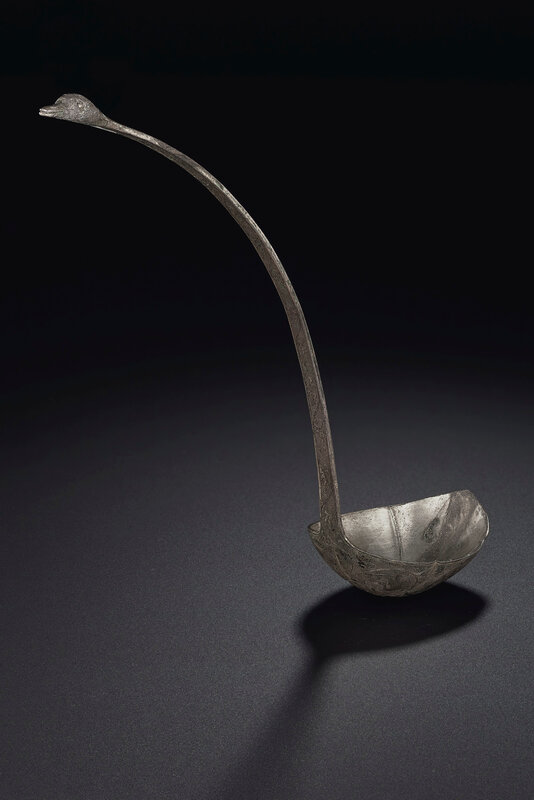





Lot 553. A fine and rare large silver ladle, Tang dynasty (618-907); 10 ¼ in. (26 cm.) long; weight 67.5 g. Estimate USD 40,000 - USD 60,000. © Christie's Image Ltd 2019.
The deep, petal-lobed bowl is finely engraved on the exterior with three birds amidst leafy foliate scroll on a minutely ring-punched ground, and the long handle is decorated with further foliate scroll and terminates in a bird's head.
Provenance: Dr. Johan Carl Kempe (1884-1967) Collection, Sweden, before 1953, no. CK105.
Sotheby's London, Masterpieces of Chinese Precious Metalwork. Early Gold and Silver, 14 May 2008, lot 62.
Literature: Bo Gyllensvärd, Chinese Gold and Silver in the Carl Kempe Collection, Stockholm, 1953, cat. no. 105.
Bo Gyllensvärd, 'T'ang Gold and Silver', Bulletin of the Museum of Far Eastern Antiquities, No. 29, 1957, pl. 15a, fig. 95g.
Han Wei, Hai nei wai Tangdai jin yin qi cuibian [Tang Gold and Silver in Chinese and overseas collections], Xi'an, 1989, pl. 198.
Chinese Gold and Silver in the Carl Kempe Collection, The Museum of Art and Far Eastern Antiquities in Ulricehamn, Ulricehamn, 1999, pl. 110.
Exhibited: Washington, D.C., Smithsonian Institution, Chinese Gold and Silver in the Carl Kempe Collection, 1954-55, cat. no. 105.
New York, Asia House Gallery, Chinese Gold, Silver and Porcelain. The Kempe Collection, 1971, cat. no. 50, an exhibition touring the United States and shown also at nine other museums.
Note: This elegant, parcel-gilt silver ladle, with its lobed oval bowl and engraved and chased decoration of birds amidst floral scrolls reserved on a fine ring-punched ground on the exterior, is similar to several other published examples, including the example in The Art Institute of Chicago, illustrated by Clarence W. Kelley, Chinese Gold and Silver in American Collections, The Dayton Art Institute, Dayton, Ohio, 1984, no. 10 (Fig. 1); one in the Seattle Art Museum included in the exhibition, The Arts of the T'ang Dynasty, Los Angeles County Museum, 1957, no. 348; and one originally in the collections of Mrs. Christian R. Holmes and the Hon. Senator Hugh Scott, subsequently sold at Christie's New York, 2-4 December 1982, lot 399, and later illustrated in Chinesisches Gold und Silber: Die Sammlung Pierre Uldry, Zurich, 1994, pp. 166-67, no. 157. All of these also have a similar slender, curved handle that terminates in the small head of a bird.




Lot 554. A fine small parcel-gilt silver quatrefoil cup, Tang dynasty (618-907); 2 ¼ in. ( 5.7 cm.) wide; weight 27.5 g. Estimate USD 50,000 - USD 70,000. © Christie's Image Ltd 2019.
The oblong cup is formed as four bracket-lobed petals, each finely engraved on the exterior with a pair of geese, each pair shown confronting each other on either side of a foliate motif, the two pairs on the long sides shown standing and the two pairs at the ends shown in flight, all against a ring-punched ground, the details highlighted in gilding.
Provenance: Dr. Johan Carl Kempe (1884-1967) Collection, Sweden, before 1953, no. CK95.
Sotheby's London, Masterpieces of Chinese Precious Metalwork. Early Gold and Silver, 14 May 2008, lot 53.
Literature: Bo Gyllensvärd, Chinese Gold and Silver in the Carl Kempe Collection, Stockholm, 1953, cat. no. 95.
Bo Gyllensvärd, ‘T’ang Gold and Silver’, Bulletin of the Museum of Far Eastern Antiquities, No. 29, Stockholm, 1957, pl. 11b, fig. 68c, fig. 69a.
Han Wei, Hai nei wai Tangdai jin yin qi cui bian, [Tang Gold and Silver in Chinese and overseas collections], Xi’an, 1989, pl. 82.
Chinese Gold and Silver in the Carl Kempe Collection, The Museum of Art and Far Eastern Antiquities in Ulricehamn, Ulricehamn, 1999, pl. 97.
Qi Dongfang, Tangdai jin yin qi yan jiu [Research on Tang gold and silver], Beijing, 1999, pl. 19.
Exhibited: Washington, D.C., Smithsonian Institution, Chinese Gold and Silver in the Carl Kempe Collection, 1954-1955, cat. no. 95.
New York, Asia House Gallery, Chinese Gold, Silver and Porcelain. The Kempe Collection, 1971, cat. no. 43, an exhibition touring the United States and shown also at nine other museums.
Oxford, Ashmolean Museum, From Silver to Ceramic, the Potter’s Debt to Metal Work in the Graeco-Roman, Oriental and Islamic Worlds, 1986, pl. 31 (bottom).
Note: Cups of this oblong, quatrefoil shape appear to be rare. One raised on a higher foot, in the Pierre Uldry Collection, is illustrated in Chinesisches Gold und Silber, Zurich, 1994, p. 152, pl. 138. A larger (11.7 cm. long) quadrilobed bowl with rounded sides, rather than barbed petal lobes, decorated on the exterior with foliate scroll on a ring-punched ground, but raised on a low, quadrilobed foot, in The Frederick M. Mayer Collection of Chinese Art, was sold at Christie's London, 24-25 June 1974, lot 167. A plain beaten silver quadrilobed bowl with straight, flared sides, its lobes formed by indentations, in the collection of Mr. and Mrs. Rafi Y. Mottahedeh, is illustrated by Dr. Paul Singer, Early Chinese Gold & Silver, China Institute in America, New York, 1971, p. 58, no. 78, where it is dated Tang.
Bowls of lobed oblong shape are more often found with eight lobes, and of larger size, such as the example in the Asian Art Museum of San Francisco, The Avery Brundage Collection, illustrated by Clarence W. Kelley, Tang Dynasty, Chinese Gold & Silver in American Collections, The Dayton Art Institute, Dayton, Ohio, 1984, p. 65, no. 31. Another with eight lobes (15.2 cm. long) is illustrated in Sui to no bijutsu, Osaka Municipal Art Museum, 1976, no. 2-16. The origins of these lobed, oval bowls appear to be Sassanian, as evidenced by the parcel-gilt silver, lobed elliptical bowl raised on a slightly flared, oval foot ring, dated 6th century, illustrated by Ann C. Gunter and Paul Jett, Ancient Iranian Metalwork in the Arthur M. Sackler Gallery and the Freer Gallery of Art, Washington, D.C., 1992, p. 182, pl. 31.
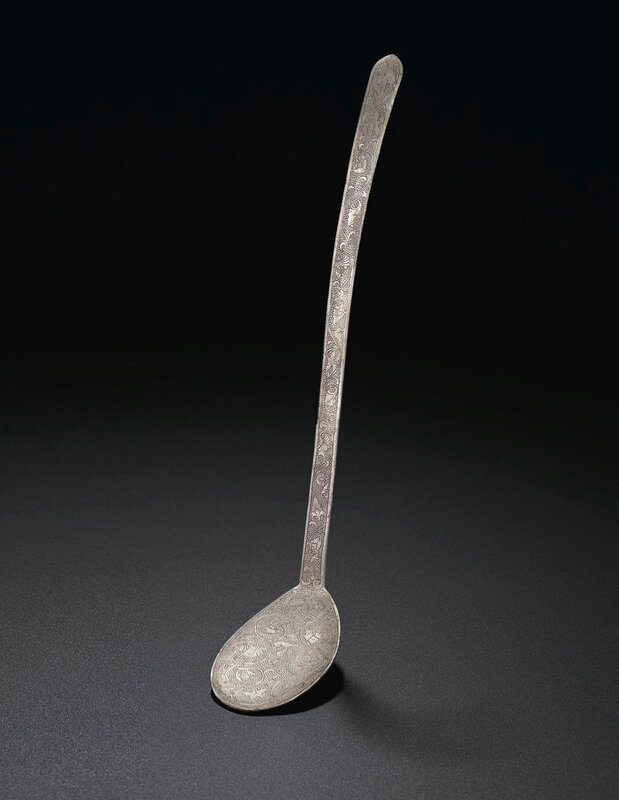
Lot 557. A rare silver spoon, Tang dynasty (618-907); 9 5/8 in. (24.5 cm.) long; weight 57 g. Estimate USD 10,000 - USD 15,000. © Christie's Image Ltd 2019.
The spoon is elegantly formed with a long flat handle engraved with a leafy, flowering vine against a ring-punched ground. The almost flat bowl is similarly chased with the vine surrounding a bird in flight.
Provenance: Dr. Johan Carl Kempe (1884-1967) Collection, Sweden, before 1953, no. CK101.
Sotheby's London, Masterpieces of Chinese Precious Metalwork. Early Gold and Silver, 14 May 2008, lot 65.
Literature: Bo Gyllensvärd, Chinese Gold and Silver in the Carl Kempe Collection, Stockholm, 1953, cat. no. 101.
Bo Gyllensvärd, 'T'ang Gold and Silver', Bulletin of the Museum of Far Eastern Antiquities, No. 29, Stockholm, 1957, pl. 10c, figs. 4b, 93n.
Han Wei, Hai nei wai Tangdai jin yin qi cuibian [Tang Gold and Silver in Chinese and overseas collections], Xi'an, 1989, pl. 202.
Chinese Gold and Silver in the Carl Kempe Collection, The Museum of Art and Far Eastern Antiquities in Ulricehamn, Ulricehamn, 1999, pl. 103.
Exhibited: Washington, D.C., Smithsonian Institution, Chinese Gold and Silver in the Carl Kempe Collection, 1954-55, cat. no. 101.
Note: A very similar silver spoon illustrated in Chinesisches Gold und Silber, Zurich, 1994, p. 167, no. 156, was previously in the collection of Mr. and Mrs. Richard Bull and included in the exhibitions, The Arts of the T'ang Dynasty, The Los Angeles County Museum, 1957, no. 347, and Early Chinese Gold & Silver, China Institute in America, New York, 1971-1972, p. 32, no. 30. It was subsequently sold at Sotheby's New York, 6 December 1983, lot 79. Similar decoration can also be seen on a smaller (12 cm. long) silver spoon excavated at Dongguomian, Xi'an, illustrated in The World of the Heavenly Khan: Treasures of the Tang Dynasty, National Palace Museum, Taipei, 2002, p. 57.


Lot 558. A rare silver petal-lobed stem cup, Tang dynasty (618-907); 2 ¾ in., (7 cm.) diam.; weight 53 g. Estimate USD 50,000 - USD 70,000. © Christie's Image Ltd 2019.
The small bowl is worked in repoussé to form ten petals, each finely engraved with small birds in flight amidst flowering plants. The lower body is similarly decorated with waterdrop-shaped, convex petals, each engraved with a bird and flowers. The knobbed and lobed foot terminates in a splayed, petal-lobed base decorated with a floral pattern.
Provenance: Dr. Johan Carl Kempe (1884-1967) Collection, Sweden, before 1953, no. CK111.
Sotheby's London, Masterpieces of Chinese Precious Metalwork. Early Gold and Silver, 14 May 2008, lot 71.
Literature: Bo Gyllensvärd, Chinese Gold and Silver in the Carl Kempe Collection, Stockholm, 1953, cat. no. 111.
Han Wei, Hai nei wai Tangdai jin yin qi cuibian [Tang Gold and Silver in Chinese and overseas collections], Xi'an, 1989, pl. 53.
Qi Dongfang, Tangdai jin yin qi yan jiu [Research on Tang gold and silver], Beijing, 1999, p. 402, fig. 3-107-4.
Exhibited: Washington, D.C., Smithsonian Institution, Chinese Gold and Silver in the Carl Kempe Collection, 1954-55, cat. no. 111.
Note: Several silver cups of this elegant shape, similarly decorated on each lobe with various birds in flight amidst plants, have been published. One in the Hakutsuru Art Museum, Kobe, Japan, is illustrated by B. Gyllensvärd, 'T'ang Gold and Silver', B.M.F.EA., No. 29, Stockholm, 1957, pl. 4b. Another from the Arthur M. Sackler Collections, and previously in the David Weill Collection, was sold at Christie's New York, 1 December 1994, lot 65. One is illustrated in Tangdai jin yin qi, Zhejiang Municipal Museum and Shaanxi Provincial Museum, 1985, figs. 7 and 8; and another was included in the exhibition, Masterpieces of Chinese Art From the Art Institute of Chicago, Osaka, Japan, Museum of Oriental Ceramics, 1989, no. 25. Two gilt-bronze examples have also been published: one in the collection of Dr. Pierre Uldry, Chinesisches Gold und Silber, Zurich, 1994, p. 151, no. 136; the other in the St. Louis Art Museum, by Clarence W. Kelley, Chinese Gold & Silver in American Collections, The Dayton Art Institute, Dayton, Ohio, 1984, p. 54, no. 20. The decoration on all of these cups is highly formal in its symmetry.



Lot 559. A small parcel-gilt silver box and cover, Tang dynasty (618-907); 1 in., (2.6 cm.) diam.; weight 8.6 g. Estimate USD 50,000 - USD 70,000. © Christie's Image Ltd 2019.
The slightly convex box and cover are chased with a formalized flower motif surrounded by small curved tendrils that issue from the narrow, outer border, all reserved on a ring-punched ground. The straight sides are similarly decorated with clouds.
Provenance: Dr. Johan Carl Kempe (1884-1967) Collection, Sweden, before 1953, no. CK91.
Sotheby's London, Masterpieces of Chinese Precious Metalwork. Early Gold and Silver, 14 May 2008, lot 84.
Literature: Bo Gyllensvärd, Chinese Gold and Silver in the Carl Kempe Collection, Stockholm, 1953, cat. no. 91.
Bo Gyllensvärd, ‘T’ang Gold and Silver’, Bulletin of the Museum of Far Eastern Antiquities, No. 29, Stockholm, 1957, fig. 80b.
Chinese Gold and Silver in the Carl Kempe Collection, The Museum of Art and Far Eastern Antiquities in Ulricehamn, Ulricehamn, 1999, pl. 93.
Exhibited: Washington, D.C., Smithsonian Institution, Chinese Gold and Silver in the Carl Kempe Collection, 1954-55, cat. no. 91.
Note: Circular silver boxes of this type were made in various sizes and with various designs. A similarly small (2.8 cm. diam.) silver box with different decoration, described as a cosmetic box, is illustrated in Tang, Eskenazi, London, 1987, no. 7.
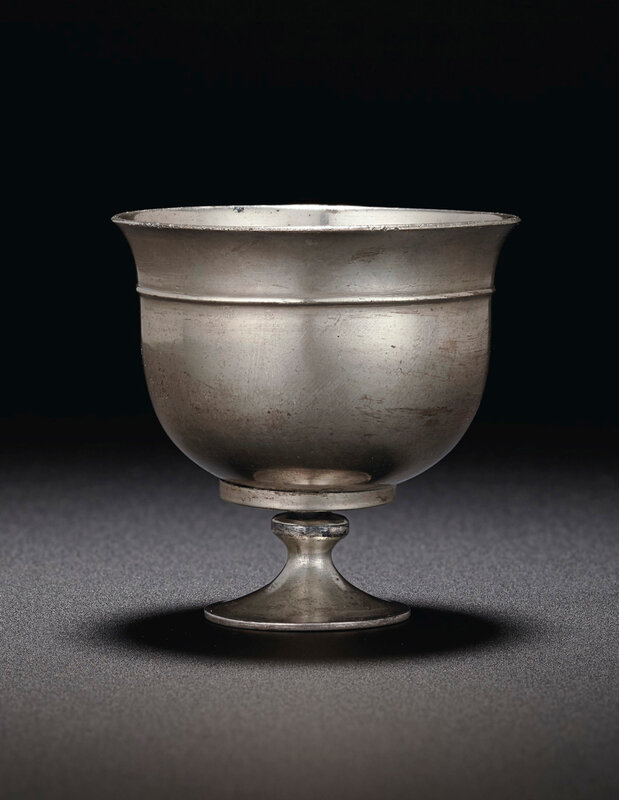

Lot 560. A rare plain silver stem cup, Tang dynasty (618-907); 2 5/8 in. (6.8 cm) high; weight 78.5 g. Estimate USD 40,000 - USD 60,000. © Christie's Image Ltd 2019.
The cup is finely formed with a bulbous body separated from the flaring rim by a bow-string band and is raised on a knobbed stem foot with splayed base..
Provenance: Dr. Johan Carl Kempe (1884-1967) Collection, Sweden.
Sotheby's London, Masterpieces of Chinese Precious Metalwork. Early Gold and Silver, 14 May 2008, lot 58.
Literature: Chinese Gold and Silver in the Carl Kempe Collection, The Museum of Art and Far Eastern Antiquities in Ulricehamn, Ulricehamn, 1999, pl. 107.
Note: Plain silver stem cups of this shape appear to be quite rare. Another plain silver cup of this shape is illustrated in Sui to no bijutsu, Osaka Municipal Art Museum, 1976, no. 2-21. Plain silver vessels of other shapes and of Tang-dynasty date have also been published including a cylindrical cup with ring handle found with a group of fifteen silver objects near the village of Shapo, southeast of the Tang capital of Chang'an, and now in the Shaanxi History Museum, illustrated by Li Jian, ed., The Glory of the Silk Road: Art from Ancient China, The Dayton Art Institute, 2003, p. 197, no. 106. Two other small plain silver vessels in the Shaanxi History Museum, of Tang date, excavated in 1970, at Hejiacun, Xi'an, Shaanxi province, are illustrated by Carol Michaelson, Gilded Dragons, British Museum, 1999, pp. 114-15, no. 76, a jar and cover, and no. 77, a circular box and cover.

Lot 561. A silver bracelet, Tang dynasty (618-907); 2 ½ in. (6.5 cm.) wide; weight 16.8 g. Estimate USD 1,000 - USD 1,500. © Christie's Image Ltd 2019.
The flat silver sheet is worked into a C-shape with tapering ends wrapped with silver wire and ending in a spiral ring at each end.
Provenance: Dr. Johan Carl Kempe (1884-1967) Collection, Sweden, before 1953.
Sotheby's London, Masterpieces of Chinese Precious Metalwork. Early Gold and Silver, 14 May 2008, lot 94.
Literature: Bo Gyllensvärd, Chinese Gold and Silver in the Carl Kempe Collection, Stockholm, 1953, cat. no. 44.
Bo Gyllensvärd, 'T'ang Gold and Silver', Bulletin of the Museum of Far Eastern Antiquities, No. 29, Stockholm, 1957, pl. 7f, fig. 70n.
Chinese Gold and Silver in the Carl Kempe Collection, The Museum of Art and Far Eastern Antiquities in Ulricehamn, Ulricehamn, 1999, pl. 42.
Exhibited: Washington, D.C., Smithsonian Institution, Chinese Gold and Silver in the Carl Kempe Collection, 1954-55, cat. no. 44.
New York, Asia House Gallery, Chinese Gold, Silver and Porcelain. The Kempe Collection, 1971, cat. no. 19, an exhibition touring the United States and shown also at nine other museums.
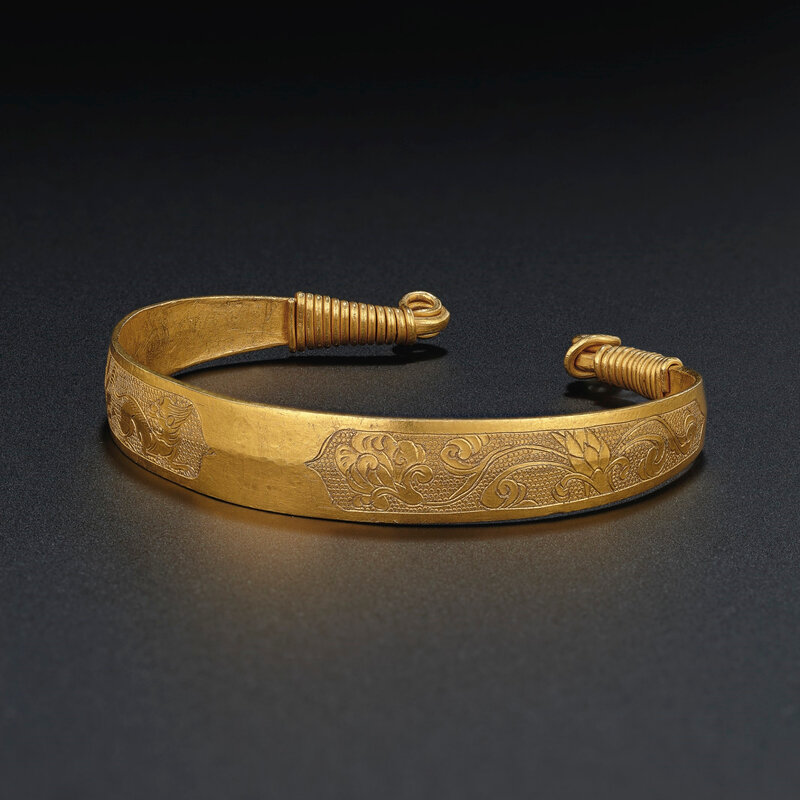
Lot 562. A gold bracelet, Tang dynasty (618-907); 2 ½ in. (6.4 cm.) wide; weight 36.2 g. Estimate USD 20,000 - USD 30,000. © Christie's Image Ltd 2019.
The C-shaped bracelet is finely engraved with two cartouches, one enclosing a bird and a running mythical beast, the other with a scrolling lotus spray, all against a ring-punched ground. Each tapering end is wrapped with gold wire and ends in a spiraled ring.
Provenance: Dr. Johan Carl Kempe (1884-1967) Collection, Sweden, before 1953, no. CK44.
Sotheby's London, Masterpieces of Chinese Precious Metalwork. Early Gold and Silver, 14 May 2008, lot 46.
Literature: Bo Gyllensvärd, Chinese Gold and Silver in the Carl Kempe Collection, Stockholm, 1953, cat. no. 127.
Bo Gyllensvärd, 'T'ang Gold and Silver', Bulletin of the Museum of Far Eastern Antiquities, No. 29, Stockholm, 1957, fig. 28b.
Chinese Gold and Silver in the Carl Kempe Collection, The Museum of Art and Far Eastern Antiquities in Ulricehamn, Ulricehamn, 1999, pl. 128.
Exhibited: Washington, D.C., Smithsonian Institution, Chinese Gold and Silver in the Carl Kempe Collection, 1954-55, cat. no. 127.

Lot 564. A parcel gilt-silver comb, Tang dynasty (618-907); 3 5/8 in. (9.3 cm.) wide; weight 20.4 g. Estimate USD 10,000 - USD 15,000. © Christie's Image Ltd 2019.
The gilded upper section of the comb is decorated in repoussé with a pair of parrots in flight, each with a leafy spray in its beak, all reserved on a ring-punched ground within an outer petal border.
Provenance: Dr. Johan Carl Kempe (1884-1967) Collection, Sweden, before 1965, no. CK 180B.
Sotheby's London, Masterpieces of Chinese Precious Metalwork. Early Gold and Silver, 14 May 2008, lot 50.
Literature: Bo Gyllensvärd, 'A Botanical Excursion in the Kempe Collection', Bulletin of the Museum of Far Eastern Antiquities, No. 37, Stockholm, 1965, pl. 1a.
Chinese Gold and Silver in the Carl Kempe Collection, The Museum of Art and Far Eastern Antiquities in Ulricehamn, Ulricehamn, 1999, pl. 135.

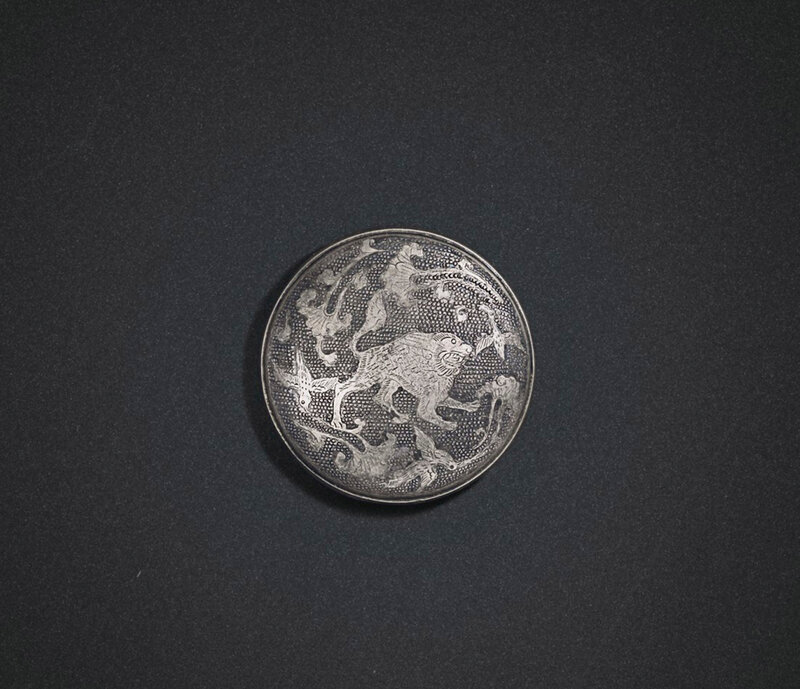

Lot 565. A small parcel-gilt silver 'Mythical beast' circular box and cover, Tang dynasty (618-907); 1 3/8 in. (3.5 cm.) diam.; weight 30 g. Estimate USD 12,000 - USD 18,000. © Christie's Image Ltd 2019.
The box and cover are finely engraved and parcel-gilt with a winged, leonine mythical beast, its mouth open in a roar, and its tail raised as it stands surrounded by three birds in flight amidst clouds, all on a minutely ring-punched ground. The straight sides are similarly decorated with detached foliate scrolls.
Provenance: Dr. Johan Carl Kempe (1884-1967) Collection, Sweden, before 1953, no. CK121.
Sotheby's London, Masterpieces of Chinese Precious Metalwork. Early Gold and Silver, 14 May 2008, lot 81.
Literature: Bo Gyllensvärd, Chinese Gold and Silver in the Carl Kempe Collection, Stockholm, 1953, cat. no. 121.
Bo Gyllensvärd, ‘T’ang Gold and Silver’, Bulletin of the Museum of Far Eastern Antiquities, No. 29, Stockholm, 1957, fig. 54g.
Han Wei, Hai nei wai Tangdai jin yin qi cui bian, [Tang Gold and Silver in Chinese and overseas collections], Xi’an, 1989, pl. 235.
Chinese Gold and Silver in the Carl Kempe Collection, The Museum of Art and Far Eastern Antiquities in Ulricehamn, Ulricehamn, 1999, pl. 124.
Exhibited: Washington, D.C., Smithsonian Institution, Chinese Gold and Silver in the Carl Kempe Collection, 1954-55, cat. no. 121.
Note: The decoration on this box appears to be a very rare choice as decoration for a silver box, as no other examples with this subject matter appear to have been published.

Lot 568. A fine pair of gold hairpins, Tang dynasty (618-907). Each 3 ½ in. (8.9 cm.) long; weight 14.9 and 14.7 g. Estimate USD 8,000 - USD 12,000. © Christie's Image Ltd 2019.
Each hairpin has two needle-shaped prongs connected by an elliptical head delicately decorated with very fine twisted gold wire that forms a flower head.
Provenance: Dr. Johan Carl Kempe (1884-1967) Collection, Sweden, before 1953, no. CK51.
Sotheby's London, Masterpieces of Chinese Precious Metalwork. Early Gold and Silver, 14 May 2008, lot 88.
Literature: Bo Gyllensvärd, Chinese Gold and Silver in the Carl Kempe Collection, Stockholm, 1953, pl. 51.
Bo Gyllensvärd, 'T'ang Gold and Silver', Bulletin of the Museum of Far Eastern Antiquities, No. 29, Stockholm, 1957, fig. 13c.
Chinese Gold and Silver in the Carl Kempe Collection, The Museum of Art and Far Eastern Antiquities in Ulricehamn, Ulricehamn, 1999, pl. 48.
Exhibited: Washington, D.C., Smithsonian Institution, Chinese Gold and Silver in the Carl Kempe Collection, 1954-55, cat. no. 51.


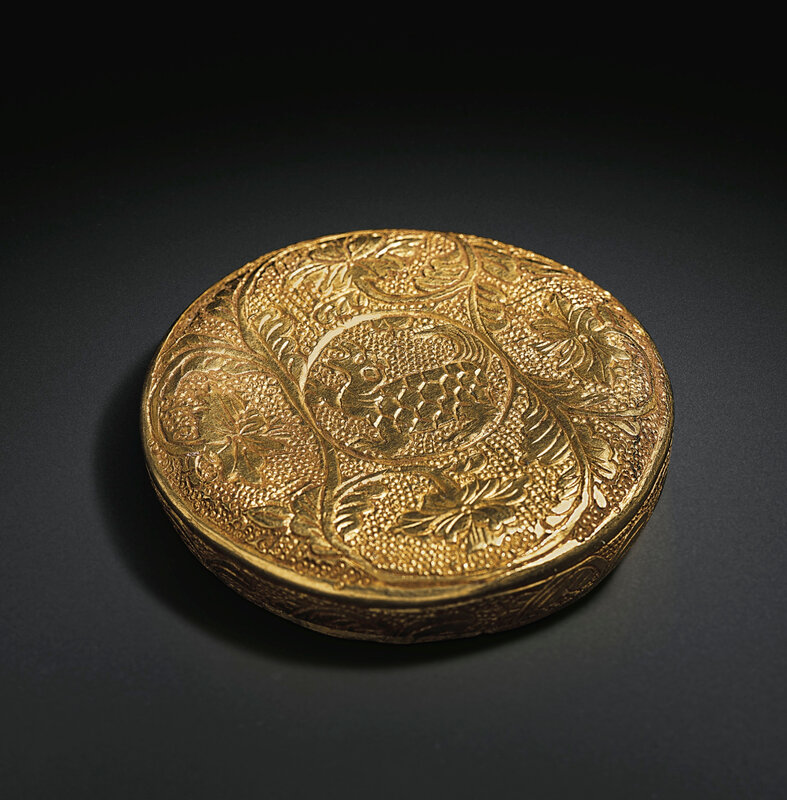

Lot 569. A circular gold 'Tortoise' box and cover, Tang dynasty (618-907); 1 1/8 in. ( 2.9 cm.) diam.; weight 16.3 g. Estimate USD 30,000 - USD 50,000. © Christie's Image Ltd 2019.
One side of the circular box is delicately chased with a circular medallion of a tortoise with raised head walking amidst peony scroll, the other side is decorated with a circular medallion of a flower surrounded by scrolling, leafy sprays, and the upright sides with foliate scroll, all reserved on a fine ring-punched ground.
Provenance: Dr. Johan Carl Kempe (1884-1967) Collection, Sweden, before 1953, no. CK41.
Sotheby's London, Masterpieces of Chinese Precious Metalwork. Early Gold and Silver, 14 May 2008, lot 80.
Literature: Bo Gyllensvärd, Chinese Gold and Silver in the Carl Kempe Collection, Stockholm, 1953, cat. no. 41.
Bo Gyllensvärd, ‘T’ang Gold and Silver’, Bulletin of the Museum of Far Eastern Antiquities, No. 29, Stockholm, 1957, fig. 58g.
Chinese Gold and Silver in the Carl Kempe Collection, The Museum of Art and Far Eastern Antiquities in Ulricehamn, Ulricehamn, 1999, pl. 39.
Exhibited: Copenhagen, Dansk Kunstindustrimuseum, Kinas Kunst i Svensk og Dansk eje, 1950, cat. no. 173.
Washington, D.C., Smithsonian Institution, Chinese Gold and Silver in the Carl Kempe Collection, 1954-55, cat. no. 41.
Note: During the Tang dynasty, small gold and silver circular boxes were used for various purposes including holding medicinal powders and beauty products. Silver boxes were far more prevalent, many of which were gilded or parcel-gilt, a less expensive alternative to the more prestigious gold. Two other rare, small gold boxes in the collection of Pierre Uldry are illustrated in Chinesisches Gold und Silber, Zürich, 1994, p. 170, nos. 164 and 165.



Lot 573. A very rare gold headdress, 7th-9th century; 12 ¼ in. (31 cm.) wide; weight 107.3 g. Estimate USD 30,000 - USD 50,000. © Christie's Image Ltd 2019.
The semi-circular headdress is cast at each end in repoussé with a galloping horse with small antlers and flowing mane above two circular loops pendent from the lower edge and another in front of the mouth. Between the two horses is a band of floral diaper pattern centered by a large, repoussé rosette, and on the reverse are six small horizontal tubes below the upper edge, leather box.
Provenance: Dr. Friedrich Perzynski Collection, Rissen/Holstein, Germany, before 1929.
Paul Cassirer/Hugo Helbing Berlin, Chinesische Goldgegenstände und Textilien aus dem Besitze von Dr. Friedrich Perzynski, Rissen-Holstein, 15 May 1929, lot 11.
Dr. Johan Carl Kempe (1884-1967) Collection, Sweden, before 1953, no. CK42.
Sotheby's London, Masterpieces of Chinese Precious Metalwork. Early Gold and Silver. 14 May 2008, lot 90.
Literature: Bo Gyllensvärd, Chinese Gold and Silver in the Carl Kempe Collection, Stockholm, 1953, cat. no. 42.
Bo Gyllensvärd, ‘T’ang Gold and Silver’, Bulletin of the Museum of Far Eastern Antiquities, No. 29, Stockholm, 1957, figs. 41a, 53d and 87e.
Chinese Gold and Silver in the Carl Kempe Collection, The Museum of Art and Far Eastern Antiquities in Ulricehamn, Ulricehamn, 1999, pl. 40.
Exhibited: Berlin, Preussische Akademie der Ku¨nste und Gesellschaft fu¨r Ostasiatische Kunst, Chinesische Kunst, 1929, cat. no. 432.
Copenhagen, Dansk Kunstindustrimuseum, Kinas Kunst i Svensk og Dansk eje, 1950, cat. no. 172.
Washington, D.C., Smithsonian Institution, Chinese Gold and Silver in the Carl Kempe Collection, 1954-55, cat. no. 42.
New York, Asia House Gallery, Chinese Gold, Silver and Porcelain. The Kempe Collection, 1971, cat. no.17, an exhibition touring the United States and shown also at nine other museums.
Note: The decorative motifs of this very rare gold headdress are representative of the cultural exchanges that informed the art of the nomadic peoples of the northern steppes during the Tang-dynasty period. The influences came from not only Central Asia and South Asia, but also the Tang empire and the nomads themselves, with their focus on horses and the other animals with which they were familiar.
The nomadic reliance on horses is reflected in the depiction of the horses that decorate each end of the headdress. They are shown not only in a gallop but almost as if flying, their speed implied by the position of the legs, the wind-blown manes, the open mouths and their intense expressions. There is also something mythical about their representation, which includes the small flames on the sides and the small antler-like horns. Winged horses with bifurcated horns are included with other mythical winged animals depicted on the gold saddle fittings illustrated by Jenny F. So, Radiant Legacy: Ancient Chinese Gold from the Mengdiexuan Collection, vol. II, Hong Kong, 2013, pp. 40-49, where the fittings are dated 7th-9th century. Like the present headdress the fittings are gold sheet worked in repoussé.
The diaper pattern that decorates the band between the horses and the central rosette most likely shows the artistic influence of Tang-dynasty China and imitates woven fabric with alternating ring-punched and stippled grounds. It is also very possible that the rosette was originally inlaid in the center, possibly with turquoise. The loops at the ends were for the attachment of cords to secure the headdress and the loops at the bottom edge and the small tubes on the reverse for the attachment of various decorative elements.

Lot 575. Three turquoise-inlaid gold ornaments, Tang dynasty (618-907). Comb tops 3 1/8 in. (8 cm.) long; weight 3.6 g each; leather box. Rosette 1 3/8 in. (3.5 cm.) diam.; weight 1.3 g. Estimate USD 4,000 - USD 6,000. © Christie's Image Ltd 2019.
The group of ornaments is comprised of a pair of crescent-shaped comb tops, each formed from gold sheet and decorated with a central flower flanked by a pair of birds in flight, all formed by cloisons, some with turquoise inlays; and a gold rosette similarly decorated with turquoise and glass inlays.
Provenance: Dr. Johan Carl Kempe (1884-1967) Collection, Sweden, before 1953, nos. 37 and no. 38.
Sotheby's London, Masterpieces of Chinese Precious Metalwork. Early Gold and Silver, 14 May 2008, lot 85.
Literature: Bo Gyllensvärd, Chinese Gold and Silver in the Carl Kempe Collection, Stockholm, 1953, cat. nos. 37 and 38.
Bo Gyllensvärd, 'T'ang Gold and Silver', Bulletin of the Museum of Far Eastern Antiquities, No. 29, Stockholm, 1957, pl. 7e, figs.12c and 80v.
Chinese Gold and Silver in the Carl Kempe Collection, The Museum of Art and Far Eastern Antiquities in Ulricehamn, Ulricehamn, 1999, pls. 35 and 36.
Exhibited: Comb tops: Copenhagen, Dansk Kunstindustrimuseum, Kinas Kunst i Svensk og Dansk eje, 1950, cat. no. 170.
Washington, D.C., Smithsonian Institution, Chinese Gold and Silver in the Carl Kempe Collection, 1954-55, cat. nos. 37 and 38.
Comb tops: New York, Asia House Gallery, Chinese Gold, Silver and Porcelain. The Kempe Collection, 1971, cat. no. 14, an exhibition touring the United States and shown also at nine other museums.



Lot 543. A silver octagonal 'Phoenix' cup, Late Tang-Liao dynasty, 9th-12th century; 2 ½ in. (6.4 cm.) high; weight 112 g. Estimate USD 8,000 - USD 12,000. © Christie's Image Ltd 2019.
The cup is finely chased with a large phoenix standing amidst leafy scrolling foliage that continues around the sides between bands of saw-tooth pattern, all on a fine ring-punched ground. The foot is similarly decorated and the base is engraved with a central flower head. The looped, leaf-shaped handle issues from a trefoil, foliate terminal attached to the side.
Provenance: Mrs. Christian R. Holmes (1871-1941) Collection, New York.
Dr. Johan Carl Kempe (1884-1967) Collection, Sweden, before 1953, no. CK104.
Sotheby's London, Masterpieces of Chinese Precious Metalwork. Early Gold and Silver, 14 May 2008, lot 45.
Literature: Bo Gyllensvärd, Chinese Gold and Silver in the Carl Kempe Collection, Stockholm, 1953, cat. no. 104.
Bo Gyllensvärd, 'T'ang Gold and Silver', Bulletin of the Museum of Far Eastern Antiquities, No. 29, Stockholm, 1957, pl. 9c, figs. 24b, 63f, 95e.
Chinese Gold and Silver in the Carl Kempe Collection, The Museum of Art and Far Eastern Antiquities in Ulricehamn, Ulricehamn, 1999, pl. 109.
Qi Dongfang, Tangdai jin yin qi yan jiu [Research on Tang gold and silver], Beijing, 1999, p. 349, fig. 3-49.
Exhibited: Washington, D.C., Smithsonian Institution, Chinese Gold and Silver in the Carl Kempe Collection, 1954-55, cat. no. 104.
Christie's. Masterpieces of Early Chinese Gold and Silver, New York, 12 September 2019